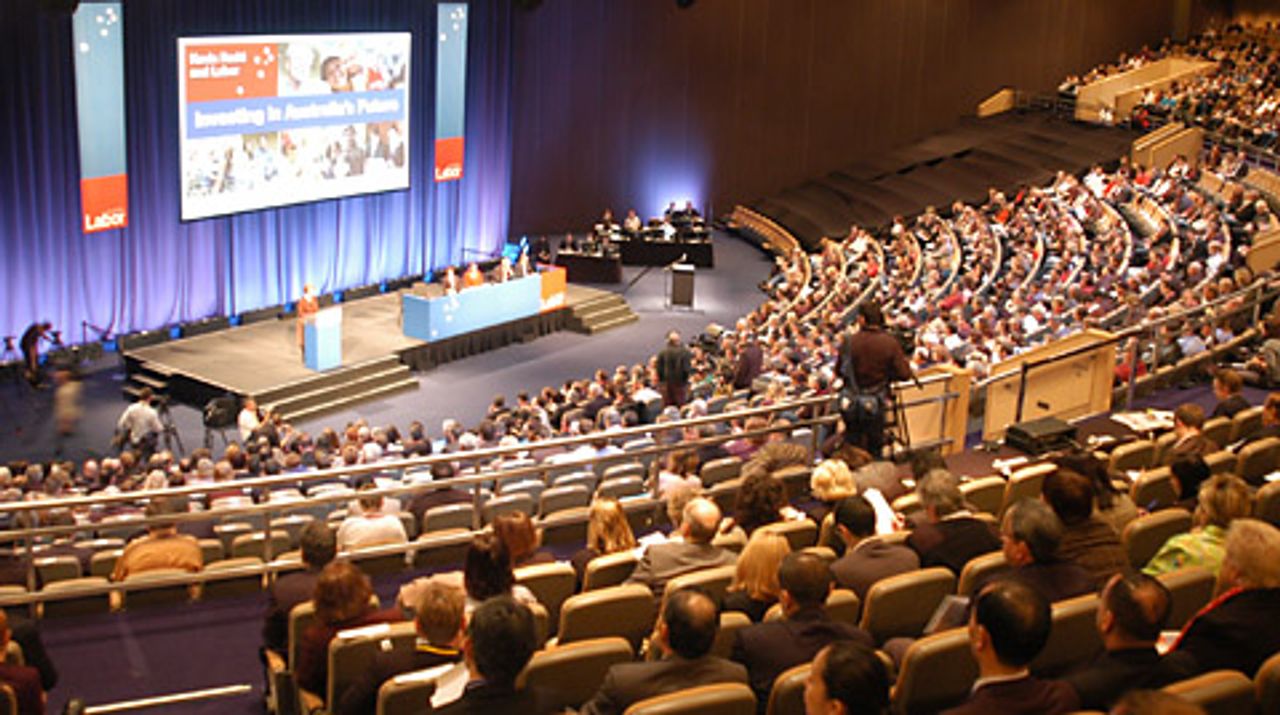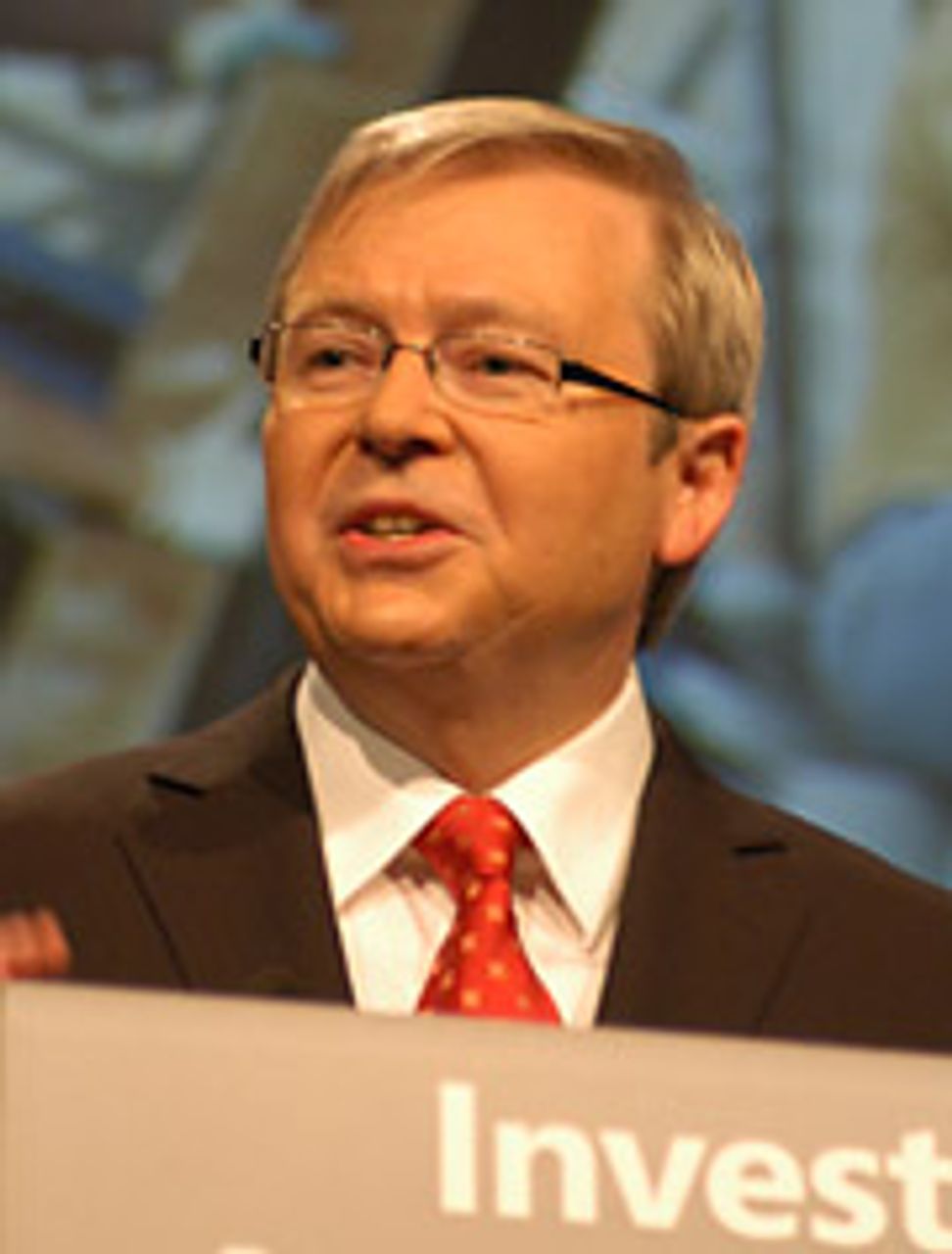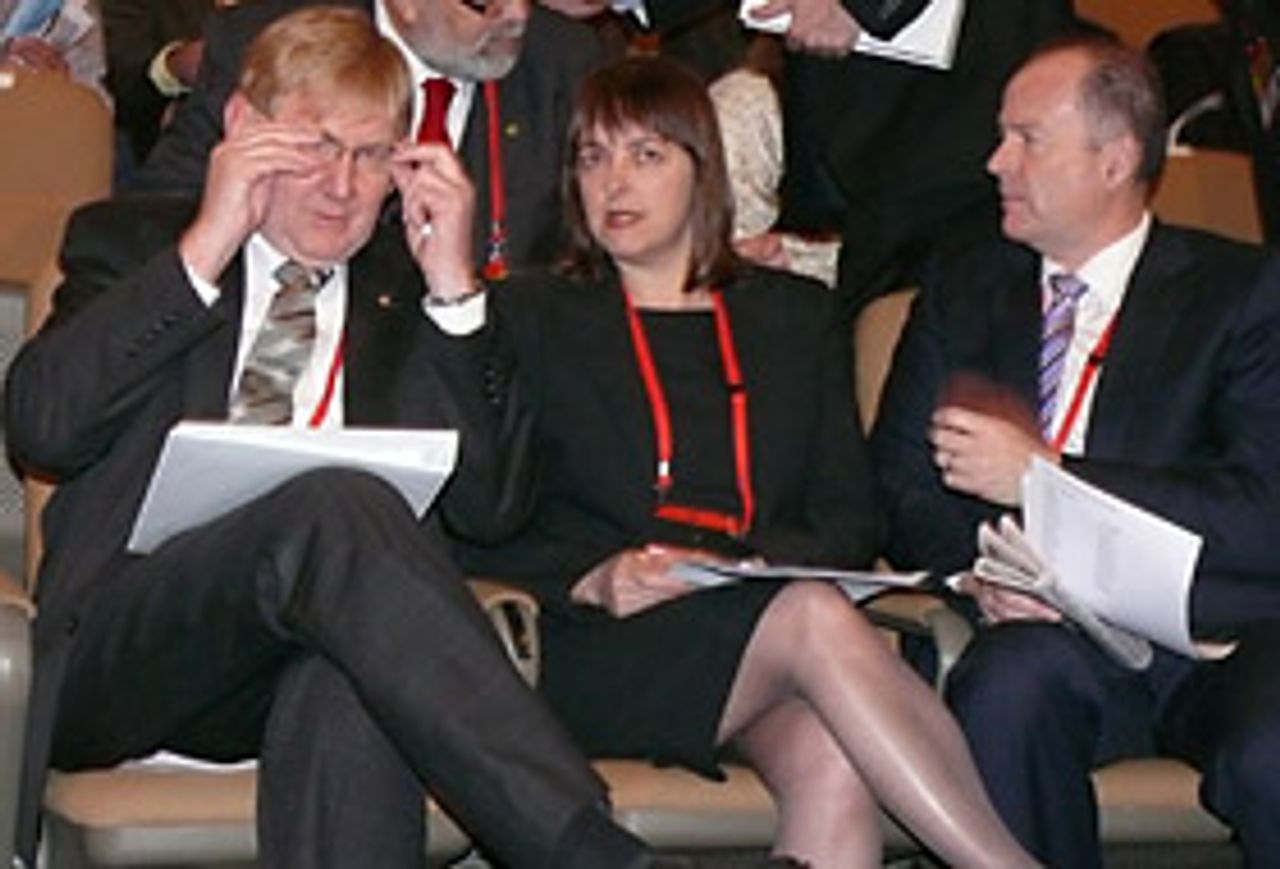Yesterday’s opening day of the Labor Party’s 45th national conference saw the assembled parliamentarians, apparatchiks, and trade union leaders issue a united and enthusiastic show of support for Prime Minister Kevin Rudd’s right-wing agenda. The display comes less than a week after Rudd published his “Pain on the road to recovery” essay, which openly outlined his government’s shift to an austerity strategy aimed at driving down the living conditions of the working class.
 The 2009 ALP National Conference
The 2009 ALP National Conference
Rudd instructed that a sombre atmosphere be projected throughout the three-day conference, in order to cast an image of a government hard at work in the face of a deepening economic crisis. Unlike previous conferences, no grand entrance, complete with blaring music, accompanied the Labor leader’s appearance at the meeting.
The prime minister’s opening address centred on an appeal to the Labor Party and trade unions for more “discipline” to ensure the government remained in office. Of Labor’s 45 conferences, Rudd reminded the assembled delegates, only 14 had been held while Labor was in power. Of the Australian parliament’s 108-year history, he continued, Labor had formed government for only 35. “These figures should be the cause for sober reflection for us all,” he concluded.
The unabashed opportunism of the appeal—that nothing must be allowed to threaten the lucrative spoils of office—clearly resonated with the assembled delegates. Deputy Prime Minister Julia Gillard received an enthusiastic ovation after she declared that Labor had completed the climb to the summit of power—“Doesn’t it feel good?” she gloated.
 Kevin Rudd
Kevin RuddRudd’s speech cast the Labor Party as the best guarantor of the long-term interests of Australian capitalism. One hundred years ago, he boasted, Labor prime minister Andrew Fisher “gave us a national bank, a national currency, a national coat-of-arms, a trans-continental railroad across the mighty Nullarbor, a national capital, and our own navy under our own national command”. John Curtin and Ben Chifley were similarly identified as “nation-builders”, as were Gough Whitlam, Bob Hawke, and Paul Keating, who, Rudd declared, “gave us national investment in infrastructure for our cities, the internationalisation of our economy and the revitalisation of our industry”.
Noting that Labor tended to come to power “at times of national adversity”, Rudd said the world economic crisis had made necessary a new economic reform agenda, centred on boosting the Australian economy’s international competitiveness by improving productivity and investing in infrastructure projects required by big business. At the same time, as part of his government’s “responsible, conservative economic management”, Rudd promised to cut public spending and return the budget to surplus.
The prime minister did not elaborate, as he did in his latest essay, on the “pain” that will accompany this agenda as far as ordinary working people are concerned, through the gutting of key social programs. This was left to other senior ministers. Treasurer Wayne Swan warned of “tough decisions ahead” and “tough medicine”. Finance Minister Lindsay Tanner noted the “endless battles” that had accompanied the Hawke-Keating economic reforms—which involved the permanent destruction of entire sections of industry along with countless jobs, and an unprecedented transfer of wealth from the working class to business and the wealthy—and declared that “the same dynamic applies now”.
This week’s Labor conference is the last ahead of the next federal election. No doubt with an eye towards the coming campaign, Rudd sought to differentiate the government from the opposition Liberal and National parties by condemning what he called their “free market fundamentalism”.
The prime minister also focussed on rising unemployment, insisting that the “paramount importance of jobs” had underlined the government’s economic stimulus measures. He announced a new government initiative supposedly creating “50,000 new green jobs, traineeships and apprenticeships”. Details of the policy, however, reveal that 30,000 of these places are not new—they merely involve additional training for trade apprentices, such as showing trainee electricians how to install “smart heating and cooling technologies”. Another 10,000 places, in the new “National Green Jobs Corps”, are to be created through what is effectively another “work for the dole” program, with the long-term unemployed made to plant trees and maintain bushland.
 Labor ministers at the conference
Labor ministers at the conferenceEvery aspect of the Labor conference has been stage managed, with discussion on the party’s platform vetted and approved by the prime minister’s office in advance. An article in the Australian yesterday explained: “Labor has appointed a four-man troubleshooting team for this week’s national conference to intervene when the 400 delegates stray from the tightly managed script. Finance Minister Lindsay Tanner, his chief of staff Anthony Baker, the ALP’s assistant national secretary Nick Martin and Kevin Rudd’s adviser Tim Dixon will act as ‘troubleshooters’ to prepare for motions from the conference floor that are contrary to government policy or likely to cause controversy.”
Adding to the farce, everyone involved knows that Rudd has reserved the right to simply ignore any decisions with which he disagrees.
Delegates yesterday unanimously voted for a resolution moved by John Sutton, of the Construction, Forestry, Mining and Energy Union (CFMEU), which called for “no reduction in company income tax revenues” to follow the government-commissioned Henry tax review. Rudd has clearly indicated that corporate taxes will be cut after the review issues its findings. While the Australian Financial Review expressed concern over the resolution, an unnamed government minister told the Sydney Morning Herald that it had been approved only because such texts were not considered binding.
The ritualistic display underscores the reality that the Australian Labor Party is no longer a political party in the commonly understood sense of the word. It does not have a mass membership base, functioning branches, or distinct tendencies representing different interests within the workers’ movement. The party is an apparatus of privileged political machine-men, bureaucrats, and trade union officials, whose daily life is entirely insulated from the interests and concerns of ordinary people.
The national conference is nothing but a public relations exercise aimed at demonstrating to big business and the media the government’s determination to proceed with the measures they have demanded. Both the Murdoch and Fairfax newspapers ran editorials this week approving of Rudd’s austerity pledge, but insisting that the government get on with the job, without time consuming reviews or committee investigations. Similar instructions were no doubt issued by the dozens of CEOs and business people who paid $7,500 each to attend the conference.
Labor’s 45th conference is proving to be yet another occasion for the trade unions to demonstrate their unity with the Rudd government.
Earlier in the week, the Australian Workers Union and Australian Manufacturing Workers Union withdrew their plan to advance a protectionist proposal at the conference aimed at excluding foreign companies from government infrastructure procurements. The Rudd government headed off the issue by announcing new tendering processes mandating companies to accept tenders from Australian owned makers of steel and other raw materials.
Likewise, the CFMEU called off a planned protest by construction workers against the Rudd government’s retention of the anti-democratic Australian Building and Construction Commission (ABCC). In June, Gillard appeared at the Australian Council of Trade Unions congress and provocatively slandered building workers who were fighting to defend their jobs at Melbourne’s West Gate Bridge project. At the Labor conference the CFMEU heads are nevertheless obediently heeding the call for a disciplined show of support for the government, without any expression of even token opposition. Gillard noted appreciatively that a resolution due to be tabled by the unions on the ABCC is “consistent with government policy”.
Outside the conference, which is being held in central Sydney, the protest outfit Socialist Alliance attempted to lend the proceedings some legitimacy by staging small demonstrations. Having campaigned for a Labor victory in the 2007 election on the basis that it represented the “lesser evil” to the Liberal-National government, the middle class radicals are now seeking to create false illusions that it is possible to pressure the Labor government and the unions to the left.
